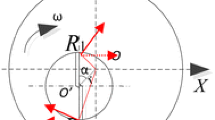Abstract
In recent years the modeling of dynamic processes in milling has become increasingly important especially in the determination of process stability. In the future the importance of these models will increase in order to establish a virtual machine tool technology. In literature several mathematical models are used for the prediction of cutting forces assuming simplified dynamic (chatter free) conditions. These models are based on different parameters which are identified in various ways. The aim of this paper is to improve the identification process for the coefficients of a basic state of the art cutting model by using a numerical optimization method. Based on this optimized model, which reflects the measured cutting force chart more precisely, dependencies of the cutting force parameters on the penetration angle are proven.




Similar content being viewed by others
References
Altintaş Y, Budak E (1995) Analytical prediction of stability lobes in milling. CIRP Ann Manuf Technol 44(1):357–362
Altintaş Y, Merdol SD (2007) Virtual high performance milling. CIRP Ann Manuf Technol 56(1):81–84
Altintaş Y (2000) Modelling approaches and software for predicting the performance of milling operations at mal-ubc. Mach Sci Technol 4(3):445–478
Denkena B, Tönshoff H (2004) Spanen. Springer, New York
Faassen R (2007) Chatter prediction and control for highspeed milling: modelling and experiments. University Press Facilities, Eindhoven
Kleckner J (2001) Ein Beitrag zur Analyse dynamischer Interaktionen bei selbsterregungsähigen Drehbearbeitungsprozessen. Dissertation, TU Darmstadt, Darmstadt
Mense C, Rott O, Hömberg D (2006) A comparison of analytical cutting force models. WIAS Preprint No. 1151
Stépán G (1990) Retarded dynamical systems: stability and characteristic functions. Longman Scientific Technical
Victor H, Kienzle O (1957) Spezifische schnittkräfte bei der Metallbearbeitung. Werkstattstechnik und Maschinenbau 47(5):224–225
Weck M, Teipel K (1977) Dynamisches Verhalten spanender Werkzeugmaschinen. Einflußgrößen, Beurteilungsverfahren, Meßgrößen. Springer-Verlag GmbH, New York
Author information
Authors and Affiliations
Corresponding author
Rights and permissions
About this article
Cite this article
Abele, E., Dietz, S. & Schiffler, A. Analysis of cutting force during milling with regards to the dependency on the penetration angle. Prod. Eng. Res. Devel. 3, 483 (2009). https://doi.org/10.1007/s11740-009-0170-4
Received:
Accepted:
Published:
DOI: https://doi.org/10.1007/s11740-009-0170-4



